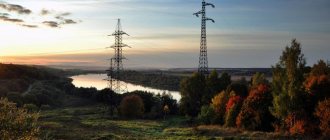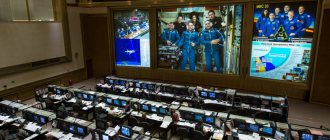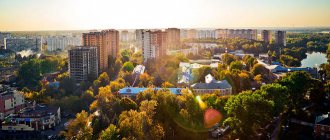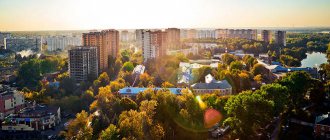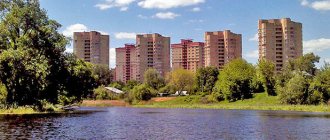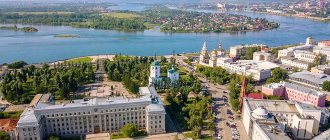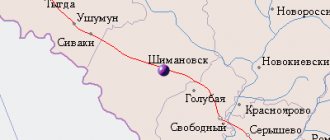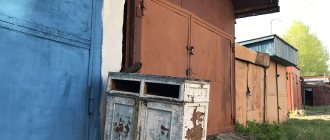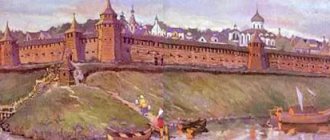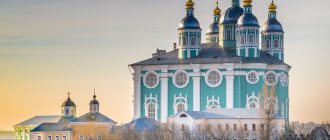City in Moscow region, Russia
| Chernogolovka Chernogolovka | |
| City [1] | |
| Flag Coat of arms | |
| Location of Chernogolovka | |
| Chernogolovka Location of Chernogolovka Show map of Russia Chernogolovka Chernogolovka (Moscow region) Show map of the Moscow region | |
| Coordinates: 56°00'N 38°22'E / 56.000°N 38.367°E / 56,000; 38.367 Coordinates: 56°00'N 38°22'E. / 56.000°N 38.367°E / 56,000; 38,367 | |
| A country | Russia |
| Federal subject | Moscow region [1] |
| First mention | 1710 [2] |
| City status from | 2001 |
| Government | |
| • Mayor | Vladimir Razumov |
| Height | 150 m (490 ft) |
| population size (2010 Census) [3] | |
| • General | 20 983 |
| • Evaluate (2018) [4] | 21 342 ( + 1,7% ) |
| Administrative status | |
| • Subordinate | City of Chernogolovka of regional subordination [1] |
| • Capital from | City of Chernogolovka of regional subordination [1] |
| Municipal status | |
| • Urban district | Chernogolovka urban district [5] |
| • Capital from | Chernogolovka urban district [5] |
| Timezone | UTC+3 (MSK[6]) |
| Postal code [7] | 142432 |
| Dialing code(s) | +7 49652 |
| OKTMO ID | 46781000001 |
| Web site | www.chernogolovka.net |
Chernogolovka
(Russian: Chernogolovka) is a city in Moscow Oblast, Russia. The city center is located approximately 43 km (27 miles) northeast of the Moscow border and 59 km (37 miles) from Red Square. Its population in 2022 was 21,342.
History and etymology
Coat of arms (1993)
For the first time, the Chernogolov volost was mentioned among other palace villages and volosts in the spiritual letter (will) of the Great Moscow Prince Ivan Kalita (about 1339; according to other sources, 1336), written to his second wife, Princess Ulyana, before his trip to Horde, the successful completion of which the prince was not sure of. In the letter, the Grand Duke's clerk Kostroma, in the presence of the spiritual princely fathers - priests Ephraim, David and Theodosius, wrote from the words of the prince: "... and I give to my princess with her younger children Surozhik, Mushkova Mountain, Radonezhskoe, Beli, Vora, Chernogolovl ...". This was not Ivan Kalita’s first trip to the Horde, and once again he was overcome by heavy thoughts: the road to the Khan’s Headquarters seemed irrevocable. But it was necessary to go, because it was impossible to achieve full power without a label for a great reign. He was afraid not for himself, but for his relatives, he was afraid that enmity would develop between them; Therefore, when getting ready to go on the road, I wanted to weigh everything, provide for everything. Name of the volost Chernogolovl
formed from the personal name
Chernogolov
, that is, it indicates that this area belongs to a certain
Chernogolov
. The area was named after the Chernogolovka River, as well as the village of Chernogolovka.
It was first mentioned as the village of Chernogolovka in 1710. In 1956, construction began on a branch of the Institute of Chemical Physics and a village attached to it. In the 1970s, Chernogolovka became a Scientific Center of the USSR Academy of Sciences.
In 1975, Chernogolovka was transformed into an urban-type settlement, and in 2001 it received city status. In 2008, Chernogolovka was awarded the status of a science city.
In 2012, a representative of the scientific intelligentsia, Corresponding Member, won the election for mayor of the city. RAS V. F. Razumov, who resigned before the end of his term of office.
Chernogolovka
The Chernogolovl volost was first mentioned along with other palace villages and volosts in the spiritual letter of the Moscow prince Ivan Danilovich Kalita (1336 or 1339), addressed to Princess Ulyana, the prince’s second wife, before his trip to the Horde: “...and I give to my princess and her younger children Surozhik , Mushkova Mountain, Radonezh, Beli, Vora, Chernogolovl...” The name of the volost later gave the name to the village, then to the scientific center, and now to the city – Chernogolovka. According to local historian Alexander Melnikov, the ancestor of Chernogolovka was the small village of Fomino, which in official documents was called Fomino (Chernogolovka). In the 14th century there were 3 peasant households in the village, and in the 18th there were a little more than ten. Administratively, the village belonged to Departure Stan, which did not belong to the palace lands. During the volost division of the districts in 1797, the Chernogolov volost was transformed into Yamkinskaya, and the village of Chernogolovka was included in the Ivanovo volost of the Bogorodsky district.
Under the modern name Chernogolovka, the first mention of the village dates back to 1710. The chronicle reports that the village was located on the Stromynsky tract, next to the large Trinity road leading from Bogorodsk to the Trinity-Sergius Lavra (now the city of Sergiev Posad). In Chernogolovka there was an inn located near the Bolshaya Stromynskaya road. The most active traffic along the Stromynskaya road occurred at the end of the 13th century, after the emergence and rapid development of the Ivanovo-Shuisky industrial region. Finished products and raw materials were transported here along Bolshaya Stromynka by horse-drawn transport through Moscow.
origin of name
According to the main (official) version, the name of the Chernogolov volost comes from the surname (nickname) of its owner - a certain Chernogolov, thus in Russia until the 19th century many names of populated places were formed - from the first settlers or their owners. According to the assumption of Noginsk local historian Alexei Simonov, Chernogolov was not just a local landowner, but the leader of the Vyatichi, and somewhere on the banks of the Chernogolovka River is his grave - a mound.
There are other versions. For example, historian-cartographer Vladimir Kusov believed that the Chernogolovka River in its upper reaches was simply called Chernaya. And according to V. Dahl’s dictionary: “Head - ... top or peak, beginning: the head of the river, the top of the river.” Those. the name of the river can be interpreted as “a river originating in a black swamp.” The “Geographical Dictionary of the Moscow Region” indeed states that the Chernogolovka River flows from a swamp near the village of Yakimovo.
Chernogolovka in the 19th century
In the List of populated places of the Moscow province for 1862, two Chernogolovkas are indicated: Fomino (Chernogolovka) and Chernogolovsky settlement (Chernogolovka) - both villages owned by the Bogorodsky district, located 17 versts from the district town of Bogorodsk (next to each other), Fomino - near the river Pruzhenka, Chernogolovsky settlement - near the Chernogolovka river. In the village of Fomino there were 23 households and 176 residents of both sexes - 90 males and 86 females. In the village of Chernogolovsky settlement, 6 households and 40 residents of both sexes are indicated - 20 males and 20 females. For the Chernogolovsky settlement, a note was made: “Here, in addition to temporary peasants, there are several courtyards belonging to Bogorodsky townspeople who settled on the owner’s lands.”
In the second half of the 19th century there was no school in Chernogolovka; out of 200 people, only 19 men and 2 women were literate. And they could only read the advertisement, write their name, and count to one hundred. In 1892, a zemstvo school was opened in the house of a local peasant, Monakhov, attended by 20 students. Its teacher was Serafima Sergeevna Solovyova, a stalwart noblewoman who graduated from the gymnasium with a gold medal. In 1897, a standard school building was built in the village, located near the Stromynsky tract, not far from the peasant houses of Malaya Chernogolovka.
Recent history, Science City
In 1956, a new page was opened in the history of Chernogolovka, when here, on the initiative of Academician Nikolai Nikolaevich Semenov (Nobel laureate in chemistry), the construction of an experimental branch of the Institute of Chemical Physics (Moscow) began, which in the 1960–1970s. was replenished by other academic institutes and grew into a Scientific Center, now known throughout the world scientific community.
Back in 1946, the Institute of Chemical Physics was entrusted by the Council of Ministers of the USSR to lead a large complex of works (theoretical and experimental) on the atomic project, i.e. project to create an atomic bomb. In 1953, in accordance with another decree, the Institute was supposed to organize experimental technological and scientific research work on the creation of high-power explosives, also within the framework of the atomic project. In addition, the Institute was tasked with leading research in the development of high-energy solid rocket fuel. It was impossible to carry out such work in Moscow. Therefore, in August 1955, the director of the Institute of Chemical Physics, Academician N. N. Semenov, proposed creating a special experimental base for the Institute. Soon, the corresponding decision was made at the highest level - Order of the Council of Ministers of the USSR No. 1024рс dated February 28, 1956 ordered the construction of a research site at the Institute of Chemical Physics of the USSR Academy of Sciences to begin, for which the territory of the existing Test Site of the Air Force Engineering Academy named after. Zhukovsky in the Noginsk region.
The organization of work in Chernogolovka was entrusted to Fyodor Ivanovich Dubovitsky, who was appointed N. Semenov’s deputy for scientific affairs. F. Dubovitsky made a huge contribution to the formation and development of the Scientific Center, devoting almost 50 years of his life to it. The main city square and secondary school No. 82 were later named after him.
The training ground was built quickly. In 1959, following the arrival of the President of the USSR Academy of Sciences, Academician Alexander Nikolaevich Nesmeyanov, in Chernogolovka, the ICP test site was transformed into a Branch of the Institute of Chemical Physics of the USSR Academy of Sciences, F. I. Dubovitsky became its director. And in 1962, the President of the USSR Academy of Sciences, Academician Mstislav Vsevolodovich Keldysh, visited the test site; after his visit, by resolution of the Presidium of the USSR Academy of Sciences, the Noginsk Scientific Center (NSC of the USSR Academy of Sciences) was organized in Chernogolovka. Construction of the Science Center institutes began. In 1963, the Institute of Solid State Physics (ISSP) began its work. In 1964, the Institute of New Chemical Problems (INCP) was created. In 1965, the Institute of Theoretical Physics named after L. D. Landau was organized. In 1969, the Institute of Experimental Mineralogy was created. In 1970, construction began on the Experimental Plant for Scientific Instrument Making of the USSR Academy of Sciences. For the period 1978–1987 In Chernogolovka, four more new institutes began work - the Institute of Physiologically Active Substances, the Institute of Problems of Microelectronics Technology and Highly Pure Materials, the Branch of the Institute of Energy Problems of Chemical Physics, the Institute of Structural Macrokinetics and Problems of Materials Science.
In 1975, Chernogolovka was given the status of an urban settlement. In 2001, the village received city status. In 2008, the city of Chernogolovka became a science city.
The Presidium of the Research Center of the Russian Academy of Sciences includes outstanding world-famous academic scientists: Anatoly Leonidovich Buchachenko, Leopold Igorevich Leontyev, Alexander Grigorievich Merzhanov, Vladislav Borisovich Timofeev, Vladimir Evgenievich Fortov, Isaak Markovich Khalatnikov. The structure of the NCC includes two research and production enterprises and four social organizations. About 5 thousand employees work here. There are 15 academicians, 18 corresponding members of the Russian Academy of Sciences, and over 900 candidates and doctors of science working in scientific institutes.
Territorial structure
Chernogolovka has no administrative division.
The city traditionally includes: institutions (northern part of the city), central part, microdistrict “Zarechye” (a new microdistrict to the southeast of the central part, which appeared just a few years ago, housing construction is actively underway, Beregovaya St.), cottage district “ Solnechnaya Polyana" (east of the microdistrict "On the Coast"), the "Lugovoy" microdistrict (southwest of or private sector (south of the central part) and the industrial zone ("23rd kilometer") - the southernmost part city, almost adjacent to the Moscow Small Ring and the territory of military unit 58172 (village Makarovo or “Noginsk-4”), which is part of the Municipal Formation “Urban District of Chernogolovka”.
At the same time, part (with an area of about 15.5 hectares) of the industrial zone “23rd kilometer”, when the urban district of Chernogolovka was separated from the former Noginsky district in 2005, was left nominally within the Noginsky district and outside the city limits of Chernogolovka (it surrounds this area from the north, west and south); These industrial enterprises are a mineral water production plant (2.4 hectares), a distillery production plant (3.1 hectares), an alcohol storage facility (2.3 hectares), a brewery (7.2 hectares) and railway access roads. roads (0.4 hectares), address landmarks are given to them “Noginsky district, 5.5 km northwest of the village. Yamkino, industrial zone Noginsk-23, industrial site No. 1,” however, in advertising the products of these enterprises are indicated as being produced in Chernogolovka.
Links[edit]
Notes[edit]
- ^ abcde Law No. 11/2013-OZ
- ^ a b https://chernogolovka.ru/about/index.ru.html?kk=bd15a3aad6
- Russian Federal State Statistics Service (2011). “All-Russian Population Census 2010. Volume 1" [All-Russian Population Census 2010, vol. 1]. All-Russian Population Census 2010 [All-Russian Population Census 2010]
. Federal State Statistics Service. - "26. The size of the permanent population of the Russian Federation by municipalities as of January 1, 2022". Federal State Statistics Service. Retrieved January 23, 2022.
- ^ abc Law No. 61/2005-OZ
- "On the Calculation of Time". Official Internet portal of legal information
. June 3, 2011. Retrieved January 19, 2022. - Post office. Information and computing center of OASU RPO. ( Post office
).
Search for postal service objects ( postal Search for objects
) (in Russian)
Sources [edit]
- Moscow Regional Duma. Law No. 11 / 2013-OZ of January 31, 2013 “On the administrative-territorial structure of the Moscow region,” as amended. Law No. 249 / 2019-OZ of November 29, 2022 “On amendments to the Law of the Moscow Region” On the administrative-territorial structure of the Moscow Region “”. Came into force the day after official publication (January 13, 2013). Published: “Daily News. Moscow Region", No. 24, February 12, 2013 (Moscow Regional Duma. Law No. 11/2013-OZ of January 31, 2013 “ On the administrative-territorial structure of the Moscow region”
as amended by Law No. 249/2019-OZ of November 29, 2019 “
On amendments to the Law of the Moscow Region”).
"On the administrative-territorial structure of the Moscow region" . Valid from the day following the day of official publication (January 13, 2013).
- Moscow Regional Duma. Law No. 61 / 2005-OZ of February 28, 2005 “On the status and border of the Chernogolovka urban district,” as amended. Law No. 19 / 2010-OZ of March 11, 2010 “On amendments to the Law of the Moscow Region” On the status and border of the Chernogolovka urban district “”. Came into force on the date of official publication. Published: “Daily News. Moscow Region", No. 42, March 10, 2005 (Moscow Regional Duma. Law of February 28, 2005 No. 61/2005-OZ “ On the status and boundaries of the Chernogolovka urban district”
as amended by Law No. 19/2010-OZ of March 11, 2010 "
On amendments to the Moscow Law". Region "On the status and border of the Chernogolovka urban district"
. Valid from the date of official publication.).
The science
The city-forming enterprises of Chernogolovka are the enterprises of the scientific and production complex - the Scientific Center of the Russian Academy of Sciences in Chernogolovka (SCCH RAS). The Scientific Center of the Russian Academy of Sciences in Chernogolovka was created in 1956 and unites scientific organizations, scientific service and social organizations subordinate to the Russian Academy of Sciences: 7 research institutes of the Russian Academy of Sciences, Federal State Unitary Enterprise "Experimental Plant for Scientific Instrument Making", Federal State Unitary Enterprise Scientific and Technological RAS, Federal State Unitary Enterprise "Operation Directorate of the Scientific Center of the Russian Academy of Sciences in Chernogolovka" (FSUE "Operation Directorate of the Scientific Center of the Russian Academy of Sciences of the Russian Academy of Sciences"), a number of others. The average number of employees in institutions and enterprises of the Scientific Center for Chronology of the Russian Academy of Sciences is 4.9 thousand people.
Institutions of the Russian Academy of Sciences:
- institutes Institute of Solid State Physics RAS (ISSP RAS),
- Institute of Theoretical Physics named after L. D. Landau RAS (ITF RAS),
- Institute of Problems of Chemical Physics RAS (IPCP RAS),
- Institute of Experimental Mineralogy RAS (IEM RAS),
- Institute of Structural Macrokinetics and Materials Science Problems of the Russian Academy of Sciences (ISMAN),
- Institute for Problems of Technology of Microelectronics and High-Pure Materials RAS (IPTM RAS),
- Institute of Physiologically Active Substances RAS (IFAV RAS),
- Branch of the Institute of Energy Problems of Chemical Physics named after V. L. Talroze RAS (INEPCP RAS named after V. L. Talroze),
- Scientific and experimental base "Chernogolovka" of the Institute of Ecology and Evolution. A. N. Severtsov RAS,
- Laboratory of the Institute of Geochemistry and Analytical Chemistry named after. V. I. Vernadsky,
- Department of Applied Network Research of the Scientific Center of the Russian Academy of Sciences in Chernogolovka,
The Scientific Center in Chernogolovka of the Russian Academy of Sciences employs 22 corresponding members of the Russian Academy of Sciences, 259 Doctors of Science, and 653 Candidates of Science. The total number of employees of the center (including social institutions) is 4891 people.
When discussing the level of scientific research carried out in Chernogolovka, it is appropriate to refer to the opinion of Academician Zh. I. Alferov, who
Innovative activities are developed in the city.
Directions of scientific research
Main areas of research:
- chemical physics of combustion and explosion processes, formation and modification of polymers, biological processes and systems,
- kinetics and mechanism of complex chemical reactions,
- condensed matter physics,
- modern materials science,
- theoretical and mathematical physics,
- physical problems of micro- and nanoelectronics,
- pure substances and materials of electronic equipment,
- solid-flame combustion and self-propagating high-temperature synthesis (SHS),
- drug design,
- development of theoretical foundations for searching for mineral deposits.
Science city Chernogolovka - past, present and future
. Past
Chernogolovka's past was, frankly speaking, remarkable. The Moscow Region academic town was created 56 years ago on the initiative of the Nobel laureate in chemistry, academician N.N. Semenov and corresponding member F.I. Dubovitsky, who not only invested their souls in Chernogolovka, but also showed themselves to be excellent managers. Thus, some of the most talented young teachers of the USSR were carefully selected and invited on favorable terms to work in Chernogolov schools; graduates of the Moscow Conservatory taught at the music school. In Chernogolovsk secondary school No. 82 there was an observatory and a planetarium, and photographs of its classrooms, equipped with the latest technology, are periodically found in Soviet film classics. Students and graduates of the country's best universities were selected on a competitive basis to work at the Chernogolov institutes of the Russian Academy of Sciences, giving them the opportunity to engage in science in excellent conditions.
Hidden among forests, surrounded by lakes, devoid of crime and inaccessible to random people (it is impossible to get here by train), Chernogolovka has been an ideal place for people to work and live for decades.
The present
In 2008, Chernogolovka officially became a science city. Here, in seven research institutes and three branches, 38 academicians and corresponding members of the Russian Academy of Sciences, more than 300 doctors of science and 700 candidates of science work. The names of Nobel Prize laureates N.N. are associated with their scientific activities. Semenova, L.D. Landau, P.L. Kapitsa, Zh.I. Alferova, V.L. Ginzburg, A.A. Abrikosov, and more recently, in 2010, the Nobel Prize in Physics for research on graphene was received by natives of Chernogolovka, Andrei Geim and Konstantin Novoselov.
In Chernogolovka, the production of high-tech products has been established, which is carried out by both state enterprises (Experimental Plant of Scientific Instrument Making with a Special Design Bureau of the Russian Academy of Sciences (FSUE EZAN), Scientific and Technological RAS (FSUE STC "Electrontech" RAS), and commercial firms. Last year, the cost of production Here, scientific and technical products amounted to more than 10 billion rubles. In terms of the number of researchers performing scientific research and development, in terms of internal costs for scientific research and development in relation to the volume of shipped goods of its own production, in terms of the volume of high-tech products of the research and production complex, Chernogolovka occupies a leading position among the science cities of Russia. What could hinder the further development of such a city?
Let's look at the facts and figures. Of the 66 million rubles received over 5 years under the program to support science cities, the overwhelming majority of the money was spent on laying a village water supply system and a village road. It was not possible to invest a single penny in the city’s infrastructure, and even more so in innovation activities.
The fact is that, firstly, the city does not have its own lands. As a result of the division of academic lands carried out 3 years ago, more than 1,500 hectares of land ended up in the treasury of the Russian Federation. On 15 sites registered in the cadastral register, there are urban developments: multi-storey individual residential buildings, schools, kindergartens, roads, improvement facilities, real estate of legal entities and individuals, places of public recreation.
In 2009, the Administration announced its intention to accept into municipal ownership land plots free from federal property. However, this problem remains unresolved to this day, despite appeals from the city district administration and petitions from the Moscow Region government to the Federal Property Management Agency.
The current situation has paralyzed life in Chernogolovka: new ones are not being built and unfinished objects are not being put into operation, the administration cannot issue permits for construction work and improve the city, land taxes and rental payments for the use of land are not paid - it is not assigned to anyone , although in fact it is used.
Secondly, all urban infrastructure facilities: housing and communal services, boiler house, water supply system, electrical service, sewage treatment plants, outdoor sports grounds, lakes, recreation area - are federal property and are under the economic control of the Federal State Unitary Enterprise "Operation Directorate of the Scientific Center of the Russian Academy of Sciences in Chernogolovka" ( FSUE UE NTsCh RAS), which is not able to support the city. Management of the housing and communal services complex was legally recognized as a non-core activity of the Russian Academy of Sciences, the funding of which was reduced by the Ministry of Finance of the Russian Federation annually. Thus, over the past 5 years, the volume of subsidies has decreased three times, and in 2012, expenses for improvement were not planned at all.
At the same time, the list of problems of the city is growing every day. Major repairs of roads and other housing and communal services facilities have stopped. Debts to gas and electricity suppliers reached almost 40 million rubles at the end of July.
In the current situation, it is impossible to attract investment to Chernogolovka: as we remember, the land and buildings are under the jurisdiction of the Russian Academy of Sciences. Profits from the rental of premises, which are rented out to various companies, do not fall into the city budget. The city budget annually receives tens of millions of rubles less in the form of land taxes and in the form of rental payments for the use of property. The municipality, instead of investing money in modernizing buildings, is forced to pay more than 13 million rubles annually to the Russian Academy of Sciences. as rent for premises housing administrative structures, cultural, sports and leisure facilities.
I would like to talk about leisure separately. The only cinema, also known as a concert hall in the city - the House of Scientists of the Scientific Center for Chronology of the Russian Academy of Sciences - is located in the building of a standard cinema, commissioned in 1967. The auditorium is practically not heated. The KPT-23 cinema equipment, installed in 1967, is morally and technically outdated. The lack of a standard-sized stage creates great difficulties for performers of large concert programs (and there are plenty of talented groups in the city).
The sports complex of the Scientific Center for Chronology of the Russian Academy of Sciences is younger than the House of Scientists. It was built in 1976. The building is designed rationally, does not need reconstruction or redevelopment, but it needs major repairs costing more than 55 million rubles. — the roof needs to be changed, the façade, the swimming pool and the gym need to be updated.
It is well known that the Moscow Region consistently allocates funds for targeted programs, including the modernization of cultural and leisure facilities, and the repair of roads and courtyards. But these programs are completely inaccessible to the city while the improvement of Chernogolovka is financed through the Russian Academy of Sciences and its lands are considered federal.
The other day, the Minister of Physical Culture, Sports and Tourism of the Moscow Region informed the Administration of Chernogolovka about accepting applications for participation in a targeted program to equip football fields of municipal buildings with artificial turf. That is, the region was ready to put our football stadiums in order. But, unfortunately, our fields are not related to the municipality, so we were denied participation,” complains Vladimir Avdonin, deputy head of the administration of the city of Chernogolovka. “At the same time, the state of our fields is disgusting. The most popular of them appeared in 1966 and is still on the balance sheet of the Russian Academy of Sciences. Due to the poor quality of the surface at the annual city tournaments, athletes suffer serious injuries here. The game is taking place behind a thick dusty curtain; there is no lawn in this place for a long time. When hosting teams, we are ready to collapse from shame. We demand that the field be handed over to the city to put it in order.
The city has been discussing the construction of a temple for more than ten years. Here is what the local priest, Father Vyacheslav, says about this: “Chernogolovka is a young city, there has never been a church here. Historically, the parish of St. Nicholas Church was closest to the city. Makarovo, of which I am the rector. The parishioners of our church are mainly residents of Chernogolovka. But from it to the village. Makarovo is 9 kilometers away, getting here is not convenient for everyone. Realizing this, we built a small wooden church at the hospital, but, of course, it cannot accommodate everyone. In 2000, Metropolitan Yuvenaly of Krutitsky and Kolomna visited our parish, who blessed the construction of a church in Chernogolovka in honor of the New Martyrs and Confessors of Russia. Since then, we have managed to do a lot: we agreed on both the land allocation and the project. But we can’t get the land for the temple into the ownership of the Russian Orthodox Church, which is necessary to start construction. The city administration fully supports us, but is not able to help, because... the land is not under her control. Correspondence with the Federal Property Management Agency has been ongoing for many years to no avail...
Both the Russian Academy of Sciences and the residents understand that these problems can only be solved in one way - by transferring the city’s land and property complex to the municipality. Then it would be possible to modernize the outdated House of Scientists and the Sports Complex through regional targeted programs and/or private funding; put the football field and sports fields in order through targeted programs; allow the construction of an Orthodox church; participate in Moscow region programs for major road repairs; earn money for the city by renting out premises; it would be possible to replenish the city budget by collecting land taxes; attract investment to the city, start new construction on the territory of Chernogolovka.
Future
The brave act of the Russian Academy of Sciences - the transfer of housing and the social sphere of the city to the municipality has led to the fact that Chernogolovka a surplus for the last three years . We have the opportunity to spend money on improvement, educational, medical and other social programs. Much attention is paid to such an important issue as creating favorable conditions for the development of all forms of entrepreneurship.
Chernogolovka is an attractive place for developing a knowledge-intensive business. We have free land for residential and industrial construction, power reserves for electricity and water supply, and a developed communications network. The city is connected by good roads with Moscow and cities in neighboring regions. The status of a science city does not provide significant tax benefits for enterprises, but we guarantee businessmen a favorable attitude, prompt resolution of their issues, and strict adherence to mutual obligations.
Directions of financing are the development of infrastructure for scientific, innovative and innovative-commercial activities, the implementation of costly innovative socially significant projects, as well as projects and activities related to the reconstruction and development of urban infrastructure. In particular, we plan to actively introduce resource-saving technologies developed by scientists into the urban economy...
In this quote, instead of Chernogolovka there was Koltsovo, and instead of Moscow there was Novosibirsk. Indeed, there is a science city near Novosibirsk, Koltsovo, in which several years ago, on the initiative of Academician Lev Stepanovich Sandakhchiev, General Director of the State Scientific Center for Virology and Biotechnology “Vector”, which was the city-forming enterprise, a bold experiment was made that gave a brilliant result. I wonder if a similar wonderful future awaits Chernogolovka or if its residents will remain captives of the land issue?
If you find an error, please select a piece of text and press Ctrl+Enter.
See also:
- RAS reform: current state of affairs (08/12/2014)
- Lessons from Stalin: the fate of the Academy of Sciences (08/27/2013)
- Will science stumble over the CPNI? (04/05/2016)
- Russia without RAS (03/08/2016)
- Russian science and scientific collections (06.11.2012)
- Obama's speech: pro and contra (06/09/2009)
- Science management reform (07/27/2015)
- Reform of the Russian Academy of Sciences and propaganda of Andrei Geim (08/15/2013)
- Reflections on the problems of higher education using the example of MIPT (04/04/2017)
Education
In Chernogolovka there are five secondary schools, of which three are municipally subordinate: Municipal Educational Institution Secondary School No. 82 (since 1962, since 2008 the school has included primary school No. 79), Municipal Educational Institution Secondary School No. 75 (since 1980), Municipal Educational Institution Secondary School "Vesta" "(since 1993) and two non-governmental educational organizations: ANOO "New Chernogolovskaya School" (since 2022, founder - JSC) and the private institution "Non-profit educational institution "ShkolYar" (since 2013).
Among the students and graduates of schools No. 82 and No. 75 there are more than a dozen winners of the All-Russian and International Olympiads for schoolchildren in physics, chemistry, mathematics, and astronomy.
Higher education is represented only by a humanitarian non-state university - the Moscow Institute of Economics, Management and Law (MIEMP).
RAS institutes have licenses for postgraduate and doctoral studies.
At the ISSP RAS, ITP RAS, IPCP RAS and IPTM RAS, basic departments of the Moscow Institute of Physics and Technology, Moscow State University, and the Faculty of Physics of the Higher School of Economics have been opened.
Art school, sports school.
Chernogolovka is a world-famous science city. Meeting with the mayor of the city Oleg Egorov
Oleg Egorov. Photo: Elena Librik, Scientific Russia.
Today, during a press tour dedicated to Vladimir Fortov and the science city of Chernogolovka (Moscow region), the Scientific Russia portal and other media met with the head of the city, Oleg Viktorovich Egorov.
Oleg Egorov ─ a graduate of the Faculty of Physics of Moscow State University ─ one of the youngest mayors of cities in Russia: at the time of taking office, in 2014, he was 33 years old. Oleg Viktorovich supports and initiates actions that strengthen the status of Chernogolovka as a science city, promotes the development of local scientific institutions, collaborates with artists to preserve the memory of Chernogolovka scientists and their discoveries in works of art.
During a meeting with journalists, Oleg Egorov spoke about the development of science, culture and education in the city, where world-famous scientists work.
“A distinctive feature of Chernogolovka and other science cities has always been a high level of education, because there were schools of the Russian Academy of Education here, famous teachers and scientists taught here using modern methods. The traditions of education in Chernogolovka are maintained at a fairly high level, as is the demand for education. Although times are difficult now, it is gratifying to see that people from science, including candidates of science, are coming to teach in our schools,” says Oleg Egorov.
Academicians V.E. Fortov and A.A. Starobinsky in the workshop of the sculptor A.S. Rodionova. Photo: E. Morozova, assistant to the head of Chernogolovka.
Science in Chernogolovka can be found everywhere: from the paintings of city walls, the interior design of restaurants and ending with educational institutions. There is a Small Academy of Sciences in the city, where children can become familiar with scientific knowledge. There is also a city school here with its own observatory, named after the famous scientist F.I. Chernogolovka. Dubovitsky. Another school, No. 75, now bears the name of academician I.M. Khalatnikov is a world-famous theoretical physicist, the first director of the Institute of Theoretical Physics named after. L.D. Landau RAS.
Recently, a park named after Academician I.M. also opened in the city. Khalatnikov, where a unique art object “Khalatnikov’s Singularity” will be installed in the near future. Its creation is carried out by the famous sculptor Artemy Rodionov.
The BHL singularity, or Belinsky-Khalatnikov-Lifshitz singularity, is a brilliant discovery in quantum physics, bringing us closer to understanding the laws of the Universe. Thanks to the work of artists, this object now has its own graphic expression, its own visual image. What is this object? A three-dimensional image of a black hole in the form of a funnel with numerous space-time deformations at the singularity point at the bottom of the funnel. The curvature of space-time near a black hole opens up fantastic opportunities for the imagination of sculptors.
Cosmological singularity. Slides courtesy of Artemy Rodionov.
Sketch of the art object “Khalatnikov’s Singularity”. A three-dimensional image of a black hole as a funnel with numerous spacetime warps at the singularity point at the bottom of the funnel . Slides courtesy of Artemy Rodionov.
Today's visit of journalists to Chernogolovka coincided with an important date for the city and science: 5 years ago, on December 23, the largest monument to scientists in the history of modern Russia was opened. The monument is dedicated to the founding scientists of Chernogolovka - Nobel Prize laureate Nikolai Nikolaevich Semenov and his student Fyodor Ivanovich Dubovitsky. Bronze figures of scientists remind residents of Chernogolovka passing by of the great importance of their small town for science.
Opening of the monument to Nikolai Nikolaevich Semenov and his student Fyodor Ivanovich Dubovitsky, December 23, 2016. Photo from the Scientific Russia archive.
A little less than two years ago, in the science city of Chernogolovka, on the initiative of young people, a unique art space was created for holding lectures, master classes, seminars and more; it operates in the format of a municipal institution and is financed from the local budget. For the first time, a science festival was held at the Voskhod art space in Chernogolovka, which attracted a lot of attention from residents and guests of the science city. The art space operates in an open-space format; guests are not tied to any specific schedule and can create their own schedule of leisure and events. An art space of this format and organized on the initiative of local residents, as Oleg Egorov noted, is unique for our country.
In the art space “Voskhod”, Chernogolovka. Photo: Elena Librik, Scientific Russia.
Project of the park named after. Academician Khalatnikov. Click to zoom. Information provided by the administration of Chernogolovka.
Oleg Egorov also told reporters about upcoming plans to develop the city’s scientific potential.
“Now we have a very good investment project in the form of the well-known chemical holding company “August”. The company will build a large scientific center for the study of applied chemistry in Chernogolovka, that is, we are talking about private science, and this, of course, is very cool, because there is not much of it in our country. Private science, as a rule, is only available to large state companies, Rosneft, etc. Chemical science will be represented here. The founder of the company is a native of Chernogolovka ,” said Oleg Egorov.
In addition, this month at the exhibition of the Agency for Strategic Initiatives, the head of Chernogolovka Oleg Egorov spoke to the President of the Russian Federation V.V. Putin with a proposal to create a network university on the basis of Russian science cities.
A network university is a special form of work, unique to our country, which will allow students of various universities to study on the basis of scientific organizations of science cities. If training is combined with real science and work on modern equipment, then there is a higher chance that students will become scientists in the future, says Egorov.
The President supported the project, and a corresponding instruction is expected to be issued. The network university project was developed within the framework of the work of the Agency for Strategic Initiatives.
In the near future we will tell you about other scientific projects of Chernogolovka. Follow our news!
Video title
The material was prepared with the support of the Ministry of Science and Higher Education and the Russian Academy of Sciences.
Transport
Chernogolovka has regular bus service with Moscow (buses No. 320 Moscow - Chernogolovka, No. 360 Moscow - Dubrovo from the Shchelkovskaya metro station from the Moscow bus station, travel time from 50 minutes (in the absence of traffic jams) to 2-3 hours (flight interval 15 —30 min., in the evening — 1 hour), from Chernogolovka from 5:00 to 22:30, from Moscow from 06:00 to 24:00), from Noginsk (No. 24, No. 24e, No. 25, average flight interval approx. 1 hour), buses to Dubrovo (No. 360), Makarovo and Ivanovskoye (No. 73), Fryanovo (minibus No. 31). There is an intracity circular route bus (No. 1Ch). Intracity and intercity taxis operate.
Passing through Chernogolovka there are also buses Moscow-Kirzhach and Moscow-Kolchugino, which do not officially stop in the city (unofficially they stop not at the bus station, but “at the ring” - the intersection of Institutsky Prospekt and Tsentralnaya Street).
In the year of Fortov’s 75th anniversary, the science city of Chernogolovka opened the doors of secret institutes
The MK correspondent visited her in the year of the 75th anniversary of the birth of one of the outstanding scientists, ex-president of the Russian Academy of Sciences Vladimir Fortov, who passed away in 2020. His name is inextricably linked with the institutes of Chernogolovka, because the academician devoted 50 years of his life to them. Vladimir Evgenievich’s daughter Svetlana Fortova, his students and colleagues took me through scientific laboratories, told me about the most interesting experiments, as well as how they managed to create... a tangible image of infinity.
Immediately at the entrance to the center of Chernogolovka, with the only traffic light in the entire town, the House of Scientists catches your eye, signs with the names of streets, parks, institutes bearing the names of outstanding local scientists: the founder of chemical physics, Nobel laureate Nikolai Semenov, another Nobel laureate - physicist Lev Landau, his colleagues, theoretical physicist Isaac Khalatnikov. By the way, five years ago, the largest monument to scientists in modern Russia was erected here - a monument dedicated to the founders of Chernogolovka - Nikolai Semenov and his colleague Fyodor Dubovitsky.
The building of the Institute of Problems of Chemical Physics of the Russian Academy of Sciences with explosive domes. Photo: Natalya Vedeneeva
Destiny city
There is a joke here that local children have no choice - after studying in local schools, where teachers with scientific degrees teach, their parents send them mainly to natural science universities, and then - as it turns out. Even the mayor here is a graduate of the physics department of Moscow State University! With the appropriate mentality. Having arrived in the city, I did not immediately find the city administration. It turned out that it does not have a separate building at all - the residence of Mayor Oleg Egorov is located on the second floor of a typical office building. “Why do I need luxury,” the head explained this discrepancy with ancient Russian traditions, “it’s better to spend the money on something useful.”
The spirit of a science city is a complex substance; there is a different pace of life here, special relationships between residents. Those arriving from the capital are advised to first tune in to Chernogolovka and be prepared for any surprises here, for example, meeting a famous academician while walking through the park. Yes, they walk the streets here like ordinary people! This is how you start discussing our mortal life with the first person you meet, and he will immediately tell you about the singularity and other plastic metamorphoses.
Moreover, there is a reason.
City administration building. Photo: Natalya Vedeneeva
Eternal uncertainty
Not long ago, a park was built in the city named after Isaac Khalatnikov, the first director of the Institute of Theoretical Physics of the Russian Academy of Sciences. Landau. The scientist would have turned 102 next year (he died in January 2021). But at first there was some hesitation regarding the sculpture that would decorate the square: after all, Khalatnikov was a theoretical physicist, cosmologist, and visualizing the mind games of people who think about the origin of the world, dark matter and the Universe as a whole is a very difficult task. In the end, the idea was born to create a funnel of a black hole in the form of a monument, and at its base, at the point of singularity (a curved region of space-time) - plastic metamorphoses (broken lines).
In the 60s of the last century, Khalatnikov became one of the authors of a chaotic solution to Einstein's gravity equation, which is called the “BHL-Singularity” (in honor of three physicists: Vladimir Belinsky, Isaac Khalatnikov and Evgeniy Lifshitz).
According to the current director of the Institute of Theoretical Physics, Igor Kolokolov, this is a discovery from the field of quantum physics, which brings us closer to understanding the laws of the Universe.
If we take it for granted that space and time as we know them in our world are infinite, then the singularity that appears at the base of the black hole funnel is the place where space-time seems to be interrupted, distorted. Scientists cannot yet fully understand what is happening to them. This “eternal uncertainty” is the gravitational singularity.
“The singularity in Khalatnikov’s equations is inevitable,” explains Kolokolov. - Either she is at the beginning, or she is at the end. You can assume that this is a black hole into which everything falls, but you can also look at it from the other side: that this is how the Universe was born.
Vladimir Fortov was the first person who was told about the idea of creating the monument “Khalatnikov Singularity”. Together with director Igor Kolokolov and another cosmologist, academician Alexei Starobinsky, the scientists wrote a letter about the advisability of such visualization of the work of the famous physicist to the city leadership. No one began to argue with the patriarchs.
Now the monument is in a local workshop; it is being created by sculptor Artemy Rodionov. In January, he promises to present his work to the public in the park. I was lucky, I saw an 8-meter art object before others: the funnel of a black hole, made of thin steel rods, as if resting below on a steel base - a singularity.
Explosive people
Accompanied by Vladimir Fortov’s daughter Svetlana, we move to the city-forming institute of Chernogolovka, the academician’s native Institute of Problems of Chemical Physics of the Russian Academy of Sciences, where until his last days he headed the Department of Extreme States of Matter. We are shown an office in which everything remains as it was under the previous owner, even the formulas and drawings on the board have not been erased.
Office of Academician of the Russian Academy of Sciences V. Fortov. Photo: Natalya Vedeneeva
We are met by the acting director of the institute, Igor Lomonosov, a student of Vladimir Fortov. He shows us the explosive domes of the institute and asks visitors to be careful on the territory of the specially protected facility, not to press any buttons or pull any levers...
This institute has 11 scientific departments employing 1,200 people. Combustion and explosions are studied here, quantum computing is carried out here, and hydrogen energy is studied.
But we, of course, are more interested in explosions, during which the properties of various materials and substances are studied.
Lomonosov immediately explains why this is needed. Here, for example, is carbon fiber, which is used in aircraft and rocket production. On the one hand, it is very durable, but on the other, it is quite fragile. It is important for specialists creating aircraft to know how it will behave under high pressure, for example, when a micrometeorite hits the ISS body. Or what to do if an asteroid 10 km in diameter arrives at us at a speed of 40 km per second? To deal with it, scientists need to know what pressure it will have in case they decide to break it into pieces or take it out of orbit.
In the dome into which we are being let in and where another explosion is about to take place, a pressure of about 100 thousand atmospheres is created.
“We are now working on an experiment to measure the speed of a shock wave in aluminum,” comments Igor Lomonosov.
Igor Lomonosov in the explosion chamber of the institute. Photo: Natalya Vedeneeva
We are asked to leave the cell. Scientists accelerate an aluminum plate to a speed of 1.5 kilometers per second and hit the sample, also aluminum, with it. There is a loud explosion behind the cell door. Such a blow, for example, can be received by a plane crashing into a rock...
There was an explosion behind this door. Photo: Natalya Vedeneeva
The institute also studies higher pressures, up to 1 million atmospheres - this is already happening at the institute’s testing sites.
— The fundamental properties of substances are studied there. For example, they simulate pressure in the Earth’s core, where it reaches 3.6 million atmospheres, and temperatures up to 10 thousand degrees Kelvin,” says Lomonosov. “We can also create pressure an order of magnitude greater than at the center of the Earth, and even higher temperatures.” Since 90 percent of the matter in the Universe is in an extreme state, our task is to understand why some substances can burn and explode while others cannot, why stars burn and planets form.
Igor Vladimirovich could not help but remember his famous teacher. He told what has always united and still unites Physics and Technology students, to whom Fortov also belonged: “We all embody the spirit of Physics and Technology, the desire to learn new things, to look beyond the horizon. Vladimir Evgenievich, like all of our science, was extreme in the breadth of his interests.
There is a small planet of Forts, but in fact he is a huge star, and in the light of this star we worked for many years.
Meanwhile, not so long ago an explosive portrait of the ex-president of the Russian Academy of Sciences was created here.
Vladimir Evgenievich was very fond of the experiment of carving a pattern on a sheet of metal with a blast wave. He said that such works are at the intersection of science and art.
Explosive portrait of Vladimir Fortov. Photo: Natalya Vedeneeva
A stencil with the image of an academician was placed on a copper plate, the explosive substance elastite was covered on top of it, and an explosion was made using a detonator attached to the plate. As a result, the image of the academician was displayed on the copper surface.
Despite the bright experiments that were shown, the problems of the science city did not hide from us. One of them is the lack of affordable housing for young people and the lack of entertainment areas. Young people get bored and travel 20 km to neighboring Noginsk for entertainment or, for example, to go to a fast food restaurant. And most importantly, additional jobs for scientists.
In the science city, even salt in cafes is served in test tubes. Photo: Natalya Vedeneeva
Both the city authorities and the relevant scientific ministry are paying attention to this. Thus, recently the Public Council under the Ministry of Science and Higher Education devoted one of its meetings to the development of science cities.
And Chernogolovka already has something to brag about - a large company producing chemical protection for plants will soon come here (a large scientific center will create 200 additional jobs for scientists). They also proposed creating a so-called distributed network institute for students on the basis of existing scientific institutes. If a student from the Urals or Siberia wanted to work on some installation, come to the science city, work, learn science in practice.
